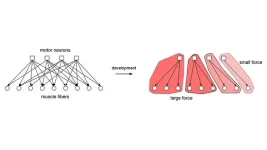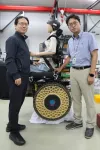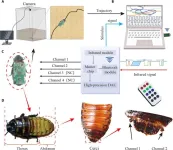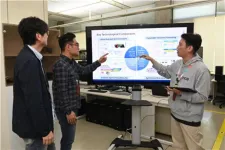(Press-News.org) Embargoed for release until 5:00 p.m. ET on Monday 2 September 2024
Annals of Internal Medicine Tip Sheet
@Annalsofim
Below please find summaries of new articles that will be published in the next issue of Annals of Internal Medicine. The summaries are not intended to substitute for the full articles as a source of information. This information is under strict embargo and by taking it into possession, media representatives are committing to the terms of the embargo not only on their own behalf, but also on behalf of the organization they represent.
----------------------------
1. False-positive mammography result may discourage women from subsequent screening
Abstract: https://www.acpjournals.org/doi/10.7326/M24-0123
Editorial abstract: https://www.acpjournals.org/doi/10.7326/M24-0893
URL goes live when the embargo lifts
A large, multi-center cohort study of more than 3 million screening mammograms in over 1 million patients aged 40 to 73 found that women were less likely to return for subsequent mammography screenings if they had a false positive recall for additional imaging or biopsy. This finding raises concerns about the potential unintended consequence of false-positive results on the continued participation of women in routine breast cancer screening. The study is published in Annals of Internal Medicine.
Cancer screening aims to catch cancer early, improving outcomes. Breast cancer screening has reduced breast cancer mortality but also comes with risks, like false positives, which are more common in younger women with denser breast tissue. Researchers from the University of California, Davis studied all screening mammograms performed from 2005 to 2017 among women aged 40 to 73 years at 177 breast imaging facilities participating in 6 U.S.-based Breast Cancer Surveillance Consortium (BCSC) registries to evaluate the association between screening mammography results and the probability of subsequent screening. The cohort included information on age, race and ethnicity, and at least 30 months of data collection after mammography to capture subsequent screening and breast cancer diagnosis. The researchers noted whether the patient had a true-negative result or a false-positive recall where they were recommended for immediate additional imaging only, short-interval follow-up, or biopsy. Then, the authors looked at absolute differences in the probability of returning for a screening within 9 to 30 months by screening result. They found that 77% of women with a true negative result returned for subsequent screening, and this percentage decreased by 2 percentage-points following a false-positive recall for additional imaging only, 16 percentage-points following a false-positive short-interval follow-up recommendation, and 10 percentage points following a false-positive biopsy recommendation. Among race/ethnic subgroups, Asian and Hispanic/Latinx women were least likely to return for future screening mammograms after a false positive result.
The authors of an accompanying editorial from Princess Margaret Cancer Centre, UHN - University Health Network - Toronto, ON, Canada suggest that these findings raise important questions about breast cancer screening, especially the guideline-recommended age to start. The 2024 U.S. Preventive Services Task Force recommends starting breast cancer screening at age 40. In the study, 29% of participants were aged 40-49 and 35.8% were 50-59. Since screening for ages 40-49 wasn't standard when the study was conducted. The authors agree that future studies are needed to both increase understanding of reasons for decreased breast cancer screening attendance after false positives and to evaluate interventions to improve subsequent screening rates.
Media contacts: For an embargoed PDF, please contact Angela Collom at acollom@acponline.org. To speak with a corresponding author, Diana L. Miglioretti, PhD, please email Stephanie Anne Winn at stawinn@ucdavis.edu.
----------------------------
2. Individualized acupuncture shows long-term efficacy in reducing chronic neck pain
Abstract: https://www.acpjournals.org/doi/10.7326/M23-2425
URL goes live when the embargo lifts
A randomized controlled trial found that individualized acupuncture may reduce chronic neck pain for up to 24 weeks when compared to sham acupuncture and a waitlist control group. Although the clinical significance remains uncertain, the findings suggest that pressure pain and sensory-based acupoints could offer a promising treatment approach for persistent neck pain. The findings are published in Annals of Internal Medicine.
Chronic neck pain is extremely common, affecting more than 280 million people globally. Researchers from Chengdu University of Traditional Chinese Medicine, Chengdu, Sichuan China randomly assigned 716 participants with chronic neck pain to one of four groups: a waiting list (WL) group or three different acupuncture groups—higher sensitive acupoints (HSA), lower sensitive acupoints (LSA), or sham acupoints (SA). Each participant in the acupuncture groups received 10 sessions over 4 weeks. The main goal was to measure the change in neck pain using a visual analogue scale (VAS) from 0 to 100, where a 10-point difference indicated a meaningful improvement. The pain levels were tracked every four weeks for up to 24 weeks to assess the long-term effects of the treatment. The researchers found that in contrast to SA and a WL control, individualized acupuncture was more effective in reducing pain for a minimum of 24 weeks. According to the researchers, these findings are important because interventions such as nonsteroidal anti-inflammatory drugs and opioids may cause undesirable adverse effects and complications. As such non-pharmacotherapy, like acupuncture, is considered a safer and more appropriate option.
Media contacts: For an embargoed PDF, please contact Angela Collom at acollom@acponline.org. To speak with corresponding authors Fanrong Liang, MD or Ling Zhao, PhD, please email zhaoling@cdutcm.edu.cn.
----------------------------
3. Researchers find substantial variations in performance characteristics between fecal immunochemical tests
Abstract: https://www.acpjournals.org/doi/10.7326/M24-0080
URL goes live when the embargo lifts
A comparative performance study of 5 commonly used fecal immunochemical tests (FIT) found substantial variations in performance characteristics between tests. According to the researchers, these findings have implications for the benefits and cost-effectiveness of CRC screening using FIT. Tests with lower sensitivity will miss more patients with CRC and advanced polyps, and tests with higher sensitivity and lower positive predictive value (PPV) will require more colonoscopies to detect patients who need treatment. The study is published in Annals of Internal Medicine.
Stool-based tests like FIT are recommended for colorectal cancer (CRC) screening because they are convenient, safe, and can be done at home without dietary restrictions. However, some FIT tests have higher rates of unusable results. Researchers from the University of Iowa sought to compare the performance characteristics of 5 commonly used FITs. A total of 3,761 participants underwent five different FITs before having a colonoscopy. The goal was to evaluate how well each test could detect advanced colorectal neoplasia (ACN), which includes advanced polyps or colorectal cancer (CRC). Four of the tests were qualitative, meaning they gave a positive or negative result, while one was quantitative, providing a numerical measure of blood in the stool. The study measured each test's sensitivity (ability to correctly identify ACN) and specificity (ability to correctly identify those without ACN), along with other factors like how often the tests gave unusable results. The researchers also analyzed which factors influenced the tests' ability to detect ACN. The researchers found substantial variation in performance characteristics between tests. Brand of FIT was the most important factor affecting sensitivity. Sensitivity was higher for participants with higher BMI and those with lower income, perhaps because this was one of their initial screenings. There was higher sensitivity in those with distal adenomas. Also, the FITs were less sensitive in women, perhaps due to higher prevalence of proximal lesions.
Media contacts: For an embargoed PDF, please contact Angela Collom at acollom@acponline.org. To speak with corresponding author Barcey Levy, MD, please email barcey-levy@uiowa.edu.
----------------------------
4. U.S. lags behind European countries in time from drug approval to reimbursement
Abstract: https://www.acpjournals.org/doi/10.7326/ANNALS-24-00614
URL goes live when the embargo lifts
A brief research report published in Annals of Internal Medicine found that the U.S. lags behind European countries in time from drug approval to reimbursement. This is important because while approval enables market entry of new drugs, insurance reimbursement is what determines patient access.
Researchers from the University of Zurich and Vanderbilt University School of Medicine used official government health care databases to study new drugs approved in the U.S., Europe, England, and Switzerland from 2011 to 2022. They tracked whether and when these drugs were approved for reimbursement in each country and analyzed the time it took from approval to reimbursement using statistical methods. Overall, in Europe, drugs are reimbursed after successful Health Technology Assessment (HTA) and price negotiation procedures. While regulatory agencies are often criticized for being slow in reimbursement decisions, the data showed that in countries like Switzerland and Germany, which use HTA systems for reimbursement, the time from drug approval to reimbursement is approximately half a year—significantly faster than in the United States, where such assessments are not used. According to the authors, adopting an HTA system and drug negotiation process in the U.S. would likely not lead to longer reimbursement timelines.
Media contacts: For an embargoed PDF, please contact Angela Collom at acollom@acponline.org. To speak with corresponding author Kerstin N. Vokinger, MD, JD, PhD please email Lst.vokinger@ius.uzh.ch
----------------------------
END
False-positive mammography result may discourage women from subsequent screening
2024-09-02
ELSE PRESS RELEASES FROM THIS DATE:
False-positive mammograms discourage some women from future screenings
2024-09-02
Early detection of breast cancer through mammography screening continues to save lives. However, abnormal findings on mammograms can lead to women being recalled for additional imaging and biopsies, many of which turn out to be “false positives,” meaning they do not result in a cancer diagnosis. False positives can also have financial implications for patients and cause significant emotional anxiety.
A major, new study led by the UC Davis Comprehensive Cancer Center has found that women who received a false-positive result that required additional imaging or biopsy were less likely to return ...
The nervous system’s matchmaker
2024-09-02
When you ask a rideshare app to find you a car, the company’s computers get to work. They know you want to reach your destination quickly. They know you’re not the only user who needs a ride. And they know drivers want to minimize idle time by picking up someone nearby. The computer’s job, says Cold Spring Harbor Laboratory Associate Professor Saket Navlakha, is to pair drivers with riders in a way that maximizes everyone’s happiness.
Computer scientists like Navlakha call this bipartite matching. It’s the same task handled by systems pairing organ donors with transplant candidates, medical students with residency ...
Open Wide: Human Mouth Bacteria Reproduce through Rare Form of Cell Division
2024-09-02
By Emily Greenhalgh
One of the most diverse ecosystems on the planet is closer than you think — right inside your mouth. Your mouth is a thriving ecosystem of more than 500 different species of bacteria living in distinct, structured communities called biofilms. Nearly all of these bacteria grow by splitting [or dividing] into two, with one mother cell giving rise to two daughter cells.
New research from the Marine Biological Laboratory (MBL) and ADA Forsyth uncovered an extraordinary mechanism of cell division in Corynebacterium matruchotii, one of the most common bacteria living in dental plaque. ...
KIMM develops wheel that alters stiffness in real time based on situation
2024-09-02
A new technology for wheels and mobile systems, necessary for overcoming various obstacles in daily life such as stairs or rocks by adjusting the stiffness of the wheel in real time, has been developed for the first time in the world. This noble technology is anticipated to find wide applications in various moving vehicles equipped with wheels, where overcoming terrain obstacles is essential.
The Korea Institute of Machinery and Materials (President Seog-Hyeon Ryu, hereinafter referred to as KIMM), an institute under the jurisdiction of the ...
Blood stem cell breakthrough could transform bone marrow transplants
2024-09-02
Melbourne researchers have made a world first breakthrough into creating blood stem cells that closely resemble those in the human body. And the discovery could soon lead to personalised treatments for children with leukaemia and bone marrow failure disorders.
The research, led by Murdoch Children’s Research Institute (MCRI) and published in Nature Biotechnology, has overcome a major hurdle for producing human blood stem cells, which can create red cells, white blood cells and platelets, that closely match those in the human embryo.
MCRI Associate Professor Elizabeth Ng said the team had made a significant discovery in human blood stem ...
Rare genetic variants linked to bicuspid aortic valve disease in young adults identified by UTHealth Houston researchers
2024-09-02
Genetic variants linked to a rare form of bicuspid aortic valve disease that affects young adults and can lead to dangerous and potentially life-threatening aortic complications have been identified by researchers at UTHealth Houston.
The study was published today in the American Journal of Human Genetics.
“We previously found that young individuals who present due to early onset thoracic aortic dissections are more likely to have bicuspid aortic valves and more likely to have rare variants in bicuspid aortic valve-associated genes,” said Siddharth Prakash, MD, PhD, co-principal investigator of the study and associate professor of medical ...
Locomotion control of cyborg insects by charge-balanced biphasic electrical stimulation
2024-09-02
A research paper by scientists at Beijing Institute of Technology proposed a universal system for remote signal output control using infrared signals.
The new research paper, published on Jul. 05 in the journal Cyborg and Bionic Systems, proposed a system that integrates high-precision digital-to-analog converters capable of generating customized waveform electrical stimulation signals within defined ranges. This enhances the accuracy of locomotion control in cyborg insects while maintaining real-time control and dynamic parameter adjustment. The proposed system is verified by experiments.
The integration of electronic stimulation devices with insects in ...
Depressed adolescents twice as likely to vape
2024-09-02
A study on vaping behaviour among Australian high school students has found those who reported severe depressive symptoms were over twice as likely to have tried e-cigarettes, compared to those reporting no depressive symptoms.
Data showed overall higher e-cigarette use among those with poorer mental health, including severe depressive symptoms, moderate and high stress, and low wellbeing.
The findings show a critical need for effective mental health support at the same time as vaping prevention during early adolescence -- when these issues first emerge.
The researchers surveyed over ...
Helping public decision-making with AI-based policy intelligence system
2024-09-02
Korean researchers are pushing for a new AI-based policy intelligence research project that can assist the public decision-making and policy execution of domestic and foreign local governments.
Electronics and Communications Research Institute (ETRI) announced on July 1 that they have decided to establish a cooperative system with the International Institute for Applied Systems Analysis (IIASA)1) to conduct further research regarding the development of an AI policy intelligence system that can assist public policy decision-making.
1) International Institute for Applied Systems Analysis (IIASA): An independent international research institute located ...
Pulmonary vein isolation vs sham intervention in symptomatic atrial fibrillation
2024-09-02
About The Study: Pulmonary vein isolation resulted in a statistically significant and clinically important decrease in atrial fibrillation burden at 6 months, with substantial improvements in symptoms and quality of life, compared with a sham procedure.
Corresponding Authors: To contact the corresponding authors, email Rick A. Veasey, MD, (rick.veasey@nhs.net) and Rajdip Dulai, MBBS, (rajdip.dulai.21@ucl.ac.uk)
To access the embargoed study: Visit our For The Media website at this link https://media.jamanetwork.com/
(doi:10.1001/jama.2024.17921)
Editor’s ...




